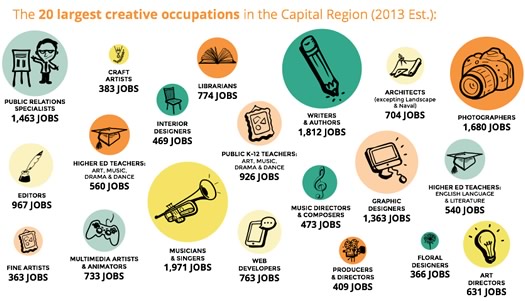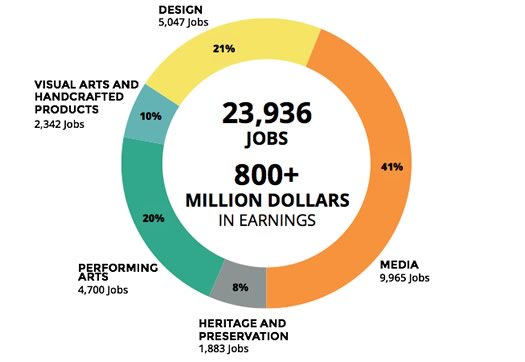Surveying the Capital Region's creative economy

From the report.
The Regional Alliance for a Creative Economy -- a local multi-org effort studying how to spur creative industries in the Capital Region -- released its report on the local creative economy today at Proctors. And -- spoilers -- it found that are many people involved in creative jobs.
The report -- "Leveraging Regional Assets for A Vibrant Future," compiled the consultancy Mt. Auburn Associates -- concluded there are 30,591 jobs in the Capital Region in what it considers creative industries. And it included a bunch of recommendations about how the region could advance these industries and, as the thinking goes, help the region as a whole.
Here are some highlights from the report, and a few thoughts.
If you just want to skip all the blah, blah, blah below and read the report for yourself, it's embedded at the bottom of this post. The images below are from the report.
Numbers

The consultancy's analysis of employment data concluded there are 30,591 jobs that could be considered "creative" employment in the eight-county region (Albany, Columbia, Greene, Rensselaer, Saratoga, Schenectady, Warren, Washington).
That pool could be further broken down:
+ 14,689 creative workers working directly in creative industries
+ 6,655 creative workers working in other industries
+ 9,247 other types of workers working in creative industries
The analysis ranked creative industries -- with 23,936 employees -- as the 6th largest employment sector in the Capital Region. And those jobs represented $800 million in earnings.
The Capital Region's share of people employed in creative industries is a bit higher than the national average. And among metros of similar size (undefined), it ranks 2nd for the highest concentration of creative jobs.
The report estimates there are 13,000 creative freelance jobs in the Capital Region.
Of the 21,344 people with creative jobs, the report concludes that film and media is the largest segment at approximately 35 percent.
Highlighted text
A handful of passages that caught our eye.
Video games
"The Capital Region is home to an authentic video game industry cluster. Thanks largely to RPI's innovative academic training offerings and business incubation, a healthy cohort of gaming companies has emerged. Vicarious Visions, the largest, now employs over 150 people at its Menands headquarters."
Electronic and experimental arts
"The Capital Region has a niche in cutting-edge performance art, experimental installations, and media and digital art. EMPAC at RPI brings international talent in the experimental arts to the region for residencies and performances."
Socioeconomic divide
"While the creative economy has led to many changes in the region, perhaps best seen in the revitalization of some of the Capital Region's urban centers, this energy is not reaching across socio-economic boundaries. In many of the region's cities, one block off the main streets there remain deep pockets of poverty."
Generational divide
"In many ways, there are two creative economies in the Capital Region, one that involves the millennials and one that involves the rest of the community. There are different networks, ways of working, and aspirations. A strong regional creative economy would involve crossing some of these divides and engaging younger residents in the leadership of the creative economy."
Information
"Given the fragmentation of the services and the various constituencies, many in the creative community remain unaware of what is available and how to access it. For example, many of the needs that freelancers identified in the survey for this project are actually available in some capacity in the Capital Region. The challenge is that there is no readily accessible source of information on resources in the region."
Recommendations
The report includes a bunch of recommendations. These are just a few that caught our eye, boiled down:
Fund for Creative Excellence
Some sort of pooled philanthropic and corporate funding to support arts and creative projects.
Video game and digital media industry
"Develop a marketing campaign and target these industries as part of the regional StartUP NY plan and other regional economic development initiatives."
Regional event
"Establish a Task Force to develop a signature creative event in the region focusing on the intersection of art,
science, and technology. Include visual, literary, and media artists in this effort."
Business support
"Develop a one-stop virtual portal that has information about all of the services available to entrepreneurs and small businesses. Additionally, expose business service providers to the creative industries to provide them a better understanding of the unique needs."
Create entrepreneurial and creative working spaces in low-income communities
"Establish a specialized maker space as part of the effort to scale-up the Center of Gravity in lower income urban neighborhoods throughout the region."
A few thoughts
Just click your heels together
We get the feeling that consultancies are often hired to play the role of Glinda the Good Witch -- to be the person to tell us that we've had the power all along, it was just a matter of recognizing it. And this report could be viewed that way -- very little in it will be surprising to anyone who's been paying attention to the arts/tech/media industries in the Capital Region.
Of course, maybe the goal is to make that point to people who haven't been paying attention.
What's creative?
Beth Siegel from Mt. Auburn Associates noted in her presentation today that the definition they used for "creative" jobs was more limited than the one used by Richard "Creative Class" Florida (he was invoked by multiple people). And the definition excluded many tech and science jobs.
Anywhere you draw the circle on what's a creative industry and what's not is going to prompt objections and criticism. And the circle can't be so wide so as become totally meaningless. But it seemed a little odd to us to include occupations such as journalism and PR while excluding jobs that involve developing creative solutions for research design or engineering. You know, is the work at a place like Ecovative not creative? (The same could probably be said for many culinary jobs.)

What is the point of creativity?
A lot of the speakers at the Proctors event framed creativity and creative endeavors as a way to drive economic growth. And that makes sense -- it is literally their job to think about that.
But the arts/creative endeavors have value beyond the economic activity they can generate -- they help us see the world differently, give us something to look forward to, make us happy. Finding ways to make money off that kind of stuff is fine, admirable even. Creative people need to make a living, and if you enjoy someone's work, you should help support that work. We just wonder if framing everything in terms of its economic worth eventually starts to lead us away from the qualities of the work/production/experience that made it mean something to us in the first place.
Top down?
Though none of the speakers at the Proctors event framed the discussion this way, a lot of the conversation was pointed in the direction of this question: How can we make the Capital Region cool? (For lack of a better word.)
Both here and in many other areas there always seems to be a desire to be more like That Cool Place. In the 90s, cities wanted to be more like Seattle. During 2000s, Austin was hot. And for the last decade, Brooklyn has been The Place. That's understandable -- all those places have had the sort of success many people are seeking.
How did Those Places get to be like that? That's a big, complicated question and one for which probably no one has whole the answer. We suspect the short answer is something along the lines of: fortunate initial conditions, groups of people who wanted to create something (and not necessarily all working together, or in the same direction), and luck.
So as we were watching executives and other officials talk about this report today, we wondered: Can That Thing that makes Those Places become The Place be generated or fostered in a top-down effort? Or is it something more self-organizing, serendipitous, and bottom-up? And is it unique to each place?
The report
Hi there. Comments have been closed for this item. Still have something to say? Contact us.
Comments
Has AOA ever considered getting into the consulting, report writing game? A lot of the analysis that I read on this site is better and more thoughtful than these cookie cutter feel good reports that state the obvious. There is good money to be made.
Or wait, maybe an even better idea, all these groups that pay big money for consultants to analyze and hypothesize mostly public information should just start reading AOA and get the information for free!
... said Shawn on Nov 14, 2014 at 11:37 AM | link
Shawn has a good point. I rely heavily on AOA if I need any information about the casinos projects (and I do, often). No one else has distilled the information as well as you guys have. I also really enjoy your thorough recaps of the Albany economic development goings-on. You guys should think about doing it for the Capital Region economic development council, too.
... said Kate on Nov 14, 2014 at 2:41 PM | link
"Create entrepreneurial and creative working spaces in low-income communities."
Translation: put artistically-talented people together in a place where nobody else wants to live, have them re-furbish the houses and create a buzz, invent a catchy real estate name (SOHO is taken), then raise the rent exponentially to bring in the people with money.
... said Thomas Dimopoulos on Nov 14, 2014 at 4:54 PM | link
@Shawn, Kate: Has AOA ever considered getting into the consulting, report writing game?
Heh. We have not. But I bet it pays a lot better.
... said Greg on Nov 15, 2014 at 9:27 AM | link